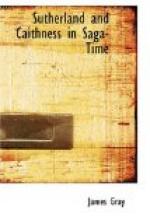William, son of Freskyn, held those lands in West Lothian and Moray probably until near the end of the twelfth century; and this William, son of Freskyn, had at least three sons,[9] (1) Hugo Freskyn, the ancestor of the de Moravias, or Murrays, of Sutherland, (2) William of Petty, and (3) Andrew, parson[10] of Duffus, who appears in a writ as a son of Freskyn, and as a brother of Hugo Freskyn of Sutherland.[11] Andrew was alive in 1190, and lived probably till 1221, and has been taken to have been the same person as Andrew Bishop of Moray who built Elgin Cathedral. More probably he was that Bishop’s uncle, and refused the bishopric of Ross. He witnessed the great Charter of Bishop Bricius founding the Cathedral at Spynie between 1208 and 1215. (Reg. Morav. c. 39).
William, son of Freskyn, probably had several other sons from one of whom were descended the Earls of Atholl.[12]
William, son of William, and so grandson of Freskyn, with whom, as he was not interested in Caithness or Sutherland, we have nothing to do, frequently appears as witness to charters in and after 1195 along with his elder brother Hugo, whom in one charter, William being the younger, is reported to call “his lord and brother."[13] This William, son of William son of Freskyn, was lord of Petty, near Fort George, and of Bracholy, Boharm, and Artildol, and died before 1226, leaving an eldest son Walter of Petty, a cousin of Sir Walter of Duffus, and from Walter of Petty are descended the great family, notorious in Orkney, of Bothwell, his great-great-grandson having been Sir Andrew of Bothwell, Wardane of Scotland, who died in 1338. William of Petty, to whom and whose descendants we now bid adieu, was probably sheriff of Invernarrin or Invernairn in 1204,[14] and uncle of another William who became first earl of Sutherland.




